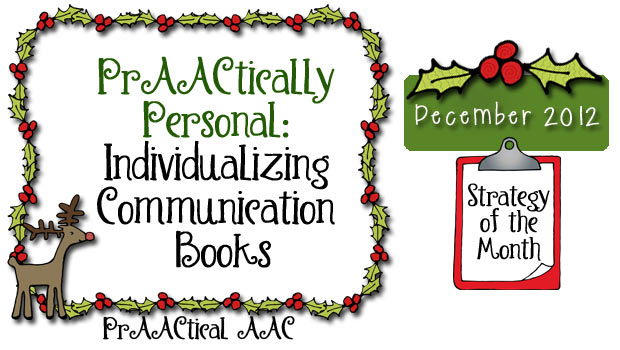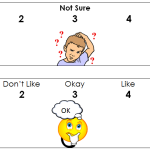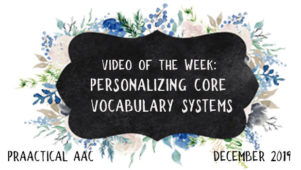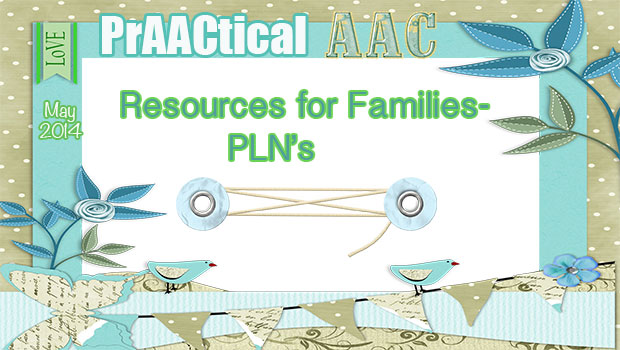PrAACtically Personal: Individualizing Communication Books

Custom tailored suit or off the shelf? Shoes that pinch or ones that are just snug? 
It stands to reason that when something fits well, we are more likely to wear it. Communication books, like clothes, have to ‘fit’ the user. But what does that really mean? When we’re ‘tailoring’ a communication book for someone who is learning to use AAC, there are three areas that we think about: How it looks, what it has inside, and how it ‘sounds.’
Appearance & Aesthetics
As we’ve said before, everyone deserves communication tools that look great. Communication books should reflect the style and personality of the person who’ll be using it. Customizing a communication book doesn’t need to be expensive. You can use special papers for the cover or pages, and stickers to decorate. Here are some ideas to get you started.
- Send them shopping: There’s nothing that speaks to ownership like going out and purchasing the communication book for yourself. This isn’t appropriate in every situation, but it could be a great experience for some of our AAC clients and their families. Discuss important parameters, like size and binding, with your client and the family first.
- Tie it to an interest: Is your client a ‘Hello Kitty’ or superhero fan? Making a book for someone who is crazy about a certain color or loves bling? Do you work with someone who loves dinosaurs, trains, manga, or a certain pop star? Think about how you could customize the book to reflect those interests. The book could have a theme (e.g., a Star Trek fan might like the idea of a ‘Captain’s Log’) or just have some of the items of interest represented in a subtler way.

- Age appropriateness matters. Our AAC friends don’t need any help from us in sticking out or looking different from their peers. If they have an interest that is not age appropriate, you will have to get creative. Elmo isn’t going to help that 9 year old fit in with his classmates, but a strip of red plush fabric on the binding might work and be just enough of a nod to his furry friend. Hmm, with a bit of checkerboard on the front, his buddies may ‘see’ Nascar instead of Sesame Street. Dora the Explorer isn’t such a great look for a 14 year old, but a book covered in Dora’s bright pink, orange, and gold colors would work just fine.
- Get crafty: Scrapbooking paper comes in every style imaginable and you can usually get a few pieces for under a dollar. Find some that your client will like and use them for the cover or internal pages. Gift wrap works well, too. Just be careful that the design of the paper doesn’t detract from their ability to derive meaning from the symbols or find the messages they need. Form follows function.
- Change it with the seasons: Some clients need an intense amount of consistency, but others can stretch themselves to accommodate change. And some people really enjoy novelty. We can reinvigorate their interest in the communication book by adding some seasonal details. If you’re using a binder style book, look for one with a cover that allows you to slip in sheets of paper. That makes it easy to give the book a fresh look for the seasons or upcoming holidays. A bonus: The ‘new look’ is a great conversation starter and communication partners will often notice the seasonal decorations and engage the learner in conversation about them.
- Be fashionable: This is a great way to reflect your client’s style, and works beautifully for teens and adults. Browse the websites of designers or page through magazines to get ideas. Think: Ed Hardy, Burberry, Betsey Johnson, Ralph Lauren, Laura Ashley. What fits your client’s style? C’mon! Don’t you need one more reason to spend time on Pinterest? “Just a minute, honey. I’m working. No, really! This is for work!”
- Get sporty: Have a football fan on your caseload? Work with a basketball lover? Team colors and logos are a great way to individualize the communication book. They are age appropriate attention-grabbers, too.
- Make it a therapy activity: Who said you have to do all of this on your own time? We love putting these books together with our AAC friends. It’s not appropriate for all clients, but there are some that really benefit from being involved in the process. Not only does it build ownership, but is great for getting them familiar with the book. And there are lots of prAACtical communication opportunities in the process. Making choices, expressing a range of preferences, commenting, rejecting, using specific sentence types to explain why they like/dislike something. The possibilities are prAACtically endless.

A word about being sloppy: Don’t. When you give someone a communication book that has typos, hastily drawn borders, photos with crooked alignment, or pieces peeling away, you are sending a message. Sloppy says “I don’t care,” ‘’You aren’t worth the time and trouble,” and “You won’t notice anyway.” To paraphrase Jane Farrall, “If the attitude with which the AAC is delivered is negative, then the user’s experience probably will be negative, too.”
Contents
The aesthetics of the book are the icing, but the contents are the real deal. The bottom line is this: If the book doesn’t have words and longer messages that reflect what the AAC user actually wants to talk about, getting him/her to use it will be an uphill battle. Finding out what they want to say is an ongoing process and there are many resources for AAC vocabulary selection. In addition to core vocabulary lists, we may use ecological inventories, checklists, and communication breakdown diaries to gather information on the contents. Detailed explanations of these methods are outside the scope of what we can address in this post, but check the Beukelman and Mirenda (2013) AAC text for further information.
For some learners, this can be integrated this into therapy sessions. For example, with Jim, a young adult, we spent 5-10 minutes out of each session talking about what to add to the book and/or how to symbolize those messages. Not only did that ensure that what he wanted was in the book, but it also helped him get familiar with the symbol for the new messages and where those messages were located.
Message Style and Tone
“No.” “No, thank you.” “Nope.” “No way.” “Not a chance.” “I don’t think so.” “Not in a million years.”
In some contexts, these messages serve as functional equivalents despite the different tones they represent. There are lots of ways to say the same thing and part of the task of making a communication book is to figure out which way is best suited for your client. Tone is everything in interaction and when we lack voice output, it’s difficult to really convey nuances in a message. Nonetheless, give some thought as to the tone.
- Should it be formal or informal?
- Direct or more subtle?
- Serious or light-hearted?
This is another area where it makes sense to involve the client and/or family in the process. One way to do it is to present the client  with some options, (I like to write them on sticky notes), and let him/her select the ones they want in their book. Another strategy is to use rating scales, an under-utilized but powerful strategy. You can download some of our scales here. Participating in the selection creates a sense of ownership and creates the ‘habit’ of being active in the customization of the tools the AAC learner will be using. “I want a drink, please” might work for one person and “Can I please get a drink?” might be better for another. We won’t know until we ask.
with some options, (I like to write them on sticky notes), and let him/her select the ones they want in their book. Another strategy is to use rating scales, an under-utilized but powerful strategy. You can download some of our scales here. Participating in the selection creates a sense of ownership and creates the ‘habit’ of being active in the customization of the tools the AAC learner will be using. “I want a drink, please” might work for one person and “Can I please get a drink?” might be better for another. We won’t know until we ask.
Final Thoughts
Busy professionals are sometimes tempted to avoid customizing the communication book to make it personal. In a perfect world, we could embrace this step fully and devote lots of time to making the book a perfect fit right away. In the real world, however, time is the enemy and we have to make compromises. Our advice? Take your time. You don’t have to wait until the book is perfect to start teaching it to the AAC learner and allowing him/her to gain skills with it. Commit to moving the customization process forward, but give yourself time to do so, Rome wasn’t built in a day. Involve other stakeholders. This is not something you can or should do alone. Whether it is selecting vocabulary, choosing how the message will sound, or making the book’s appearance fit your client’s style, there may be other team members who can help. Recruit a teenage sibling or grandparent. Maybe a friend or classmate would want to participate. Open the circle and you will not just have help in making the book, but also give those stakeholders a greater investment in the communication book. To us, that sounds like a very good thing.
Filed under: Strategy of the Month
Tagged With: aesthetics, appearance, COmmunication Books, customize, hobbies, individualize, interests, style
This post was written by Carole Zangari





2 Comments
Hi Carole, thank you for commenting on my therapeutic use of puppets video! I am so glad that you will include in your blog next month. You have a great site. I just gave you a shout out to my facebook fans so hopefully you will get some new people benefiting from your blog. Thanks again!
That’s so great, Ryan! The post is tentatively scheduled for 2/17. Our FB page is http://www.facebook.com/PrAACticalAAC. Hope we can stay connected. 🙂